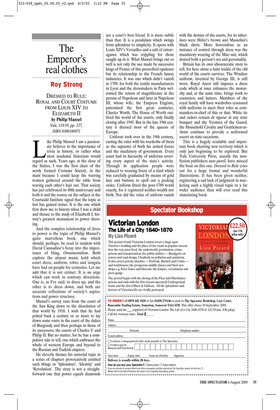The Emperor’s real clothes
Roy Strong
DRESSED TO RULE: ROYAL AND COURT COSTUME FROM LOUIS XIV TO ELIZABETH II by Philip Mansel Yale, £19.95, pp. 237, ISBN 0300106971 Like Philip Mansel I am a passionate believer in the importance of trivia in history, or rather what most academic historians would regard as such. Years ago, at the close of the Sixties, I was the first chair of the newly formed Costume Society, in the main because I could keep the warring women gathered around the table from tearing each other’s hair out. That society has just celebrated its 40th anniversary and both it and the course on the subject at the Courtauld Institute signal that the topic at last has gained status. It is the one which first drew me to history when I was a child and thence to the study of Elizabeth I, history’s greatest monument to power dressing.
And the complex relationship of dress to power is the topic of Philip Mansel’s quite marvellous book, one which should, perhaps, be read in tandem with David Cannadine’s foray into the importance of bling, Ornamentalism. Both explore the almost manic hold which court dress, uniform, robes and insignia have had on people for centuries. Let me add that it is not extinct. It is an urge which can work in contrary directions. One is, as I’ve said, to dress up, and the other is to dress down, and both are accurate reflections of society’s aspirations and power structure.
Mansel’s survey runs from the court of the Sun King down to the dissolution of that world by 1918. I wish that he had poked back a century or so more to lay down some roots in the court of the dukes of Burgundy and then perhaps in those of its successors, the courts of Charles V and Philip II. But no matter, for he has a compulsive tale to tell, one which embraces the whole of western Europe and beyond to the Russian and Turkish empires.
He cleverly themes his sartorial topic in a series of chapters provocatively entitled such things as ‘Splendour’, ‘Identity’ and ‘Revolution’. The story is not a straightforward one that power equals diamonds are a court’s best friend. It is more subtle than that. It is a pendulum which swings from splendour to simplicity. It opens with Louis XIV’s Versailles and a cult of extravagance which was crippling for those caught up in it. What Mansel brings out so well is not only the use made by successive kings of France of this prescribed opulence but its relationship to the French luxury industries. It was one which didn’t vanish in 1789, for both the textile manufacturers in Lyon and the dressmakers in Paris welcomed the return of magnificence in the person of Napoleon and later in Napoleon III, whose wife, the Empress Eugénie, patronised the first great couturier, Charles Worth. The House of Worth outlived the world of the courts, only finally closing after 1945. But in the late 19th century it dressed most of the queens of Europe.
Uniform took over in the 19th century, casting the ruler with his wardrobe of them as the supremo of both his armed forces and the machinery of government. Every court had its hierarchy of uniforms covering every aspect of the state’s activity. Through its application people were reduced to wearing livery of a kind which was carefully graduated by means of gold lace and buttons to spell out a pecking order. Uniform fitted the post-1789 world exactly, for it registered neither wealth nor birth. Nor did the value of uniform vanish with the demise of the courts, for its inheritors were Hitler’s brown and Mussolini’s black shirts. More horrendous as an instance of control through dress was the mandatory wearing of the Mao suit, which denied both a person’s sex and personality.
Britain has its own idiosyncratic story to tell, for here alone a faint trickle of the old world of the courts survives. The Windsor uniform, invented by George III, is still worn. Royal Ascot still imposes a dress code which at once enhances the monarchy and, at the same time, brings work to couturiers and hatters. Members of the royal family still have wardrobes crammed with uniforms to meet their roles as commanders-in-chief of this or that. White tie and orders remain de rigueur at any state banquet and the Yeomen of the Guard, the Household Cavalry and Gentlemen-atArms continue to provide a uniformed escort on state occasions.
This is a hugely readable and important book charting new territory which is only just beginning to be explored. But Yale University Press, usually the nonfiction publishers sans pareil, have missed the boat on this one. Dressed to Rule cries out for a large format and wonderful illustrations. It has been given neither, registering a sad lack of judgment in marketing such a highly visual topic to a far wider audience than will ever read this stimulating book.











































 Previous page
Previous page